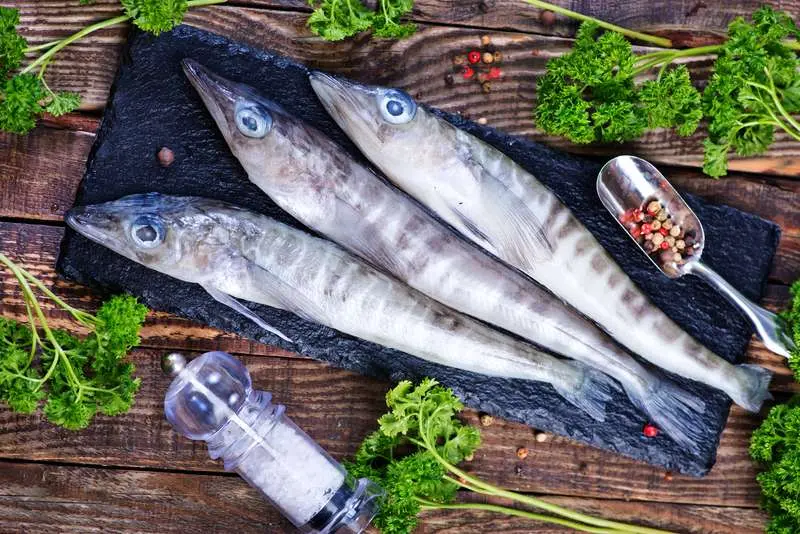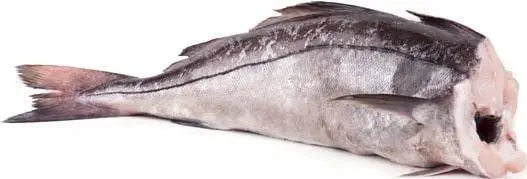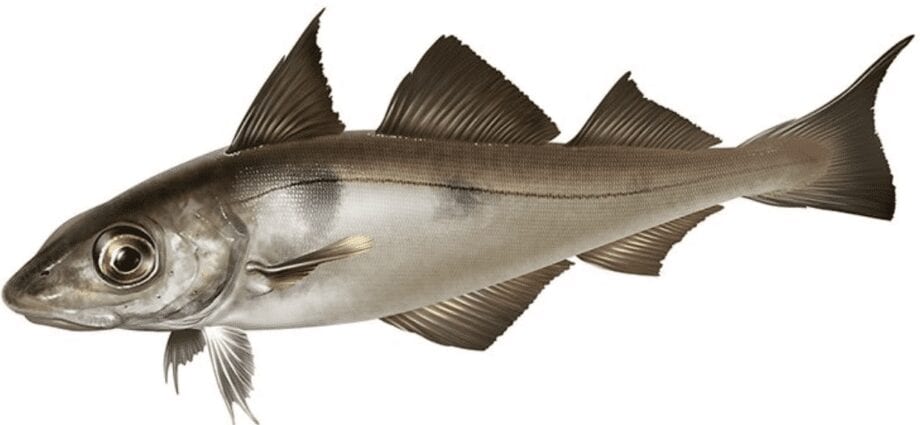Contents
Description
This northern fish allows you to cook so many interesting dishes that you can surprise your guests endlessly. Haddock is perfect to brown on the grill, bake in the oven, fish fillets are ingredients of salads, and you may cook original pates.
An industrial fish such as haddock belongs to the cod family. Haddock lives in the northern seas of the Atlantic and the Arctic oceans. This fish also inhabits the coast of Europe, North America, around Iceland, and the Norwegian and Barents Seas – in the adjacent Arctic Ocean. It is almost impossible to meet haddock in the desalinated Baltic or White Seas. This fish lives mainly in salty seas.
Haddock, in terms of the catch, is in third place among all codfish. Ahead are only cod and pollock. The North and Barents Seas, the shores of Nova Scotia and England – where haddock is an important fishery. Although it is in the International Red Book, approximately 0.5-0.7 million tons of this fish fishers catch annually.
Haddock is a relatively large fish. The length of the fish is 50-70 centimeters, the average weight of haddock is 2-3 kilograms. But it happens that specimens get into the fishermen’s nets, the dimensions of which reach 15-19 kilograms of weight and 1-1.1 meters in length. The haddock body is slightly flattened at the sides and relatively tall. The silvery fish distinguishes a milky white belly, a dark gray back with a lilac tint, and lighter sides.
Just below the back along the torso, the haddock has a black horizontal line. Near the head on each side, there is a dark oval speck. It is this speck that is a kind of identification mark for this species of fish. On it, haddocks recognize each other, gather in large flocks. This behavior allows them to notice predators earlier, in particular, large predatory fish and seals.
A distinctive feature of haddock is 2 anal and 3 dorsal fins (the first one is higher than the other two).
This northern fish is fresh in supermarkets. Also, you may buy it dried and smoked. But most often, it gets frozen. As a dietary food, haddock meat is of a high value – it is white, not greasy, and has a very delicate taste.
Haddock composition and useful properties
Because haddock meat, as, indeed, in other codfish, is low-fat, it is ideal for dietary nutrition. Haddock stores fat in the liver. This “cod” fat manufacturers melt and use for medical purposes.
Haddock is rich in protein, vitamin B12, and selenium. The fish contains pyridoxine, sodium, potassium, bromine, iron, zinc, iodine, fluorine, B vitamins, and A and D.

Like most other fish, Haddock is rich in essential amino acids; its fats contain omega-3 polyunsaturated fatty acids – alpha-linolenic and eicosapentaenoic. These acids are indispensable for the normal functioning of the eyes and brain; they allow lower cholesterol levels in the blood to cope with inflammatory processes in the body.
Haddock meat does not contain the insoluble protein elastin, which provides it with much faster and easier (compared to animal meat) digestion in the gastrointestinal tract.
Calorie content
- 100 grams of haddock contains on average 73 kcal.
- Proteins, g: 17.2
- Fat, g: 0.2
- Carbohydrates, g: 0.0
Harm and contraindications
Haddock is contraindicated for those who have individual intolerance.

Interesting Facts
Haddock is a rather valuable marine fish that can delight any fisherman. It tastes great and does not require tricks in catching, so in the places where it passes, you can enjoy the process of fishing without puffing with a spinning rod at the ready. We will tell you some interesting facts about this fish to always show off your knowledge.
Haddock is the owner of a very remarkable appearance, which is difficult to confuse with anything else. For example, its dorsal fins are split into three. The second and third completely repeat the shape of the fins on the belly, but the first, triangular and high, is very similar to the shark’s dorsal fin.
This fish leads a bottom life, usually not sinking to a depth of more than 100-200 meters. Moreover, it very rarely sails far from land. However, there are exceptions. Cases of haddock were recorded at a depth of one kilometer and quite far in the open sea.
History and geography
Although haddock ranks third in the world in terms of catch among codfish, its attitude in different countries can be the opposite. If in Russia, Germany, and several other states, haddock are clearly inferior in popularity to cod, then, for example, in Great Britain, haddock is valued much higher.
There are even several legends related to this fish. Most Britons believe that the characteristic black spot on the side of haddock is the fingerprint of St. Peter’s. But the residents of Filey, Yorkshire, have completely opposite assumptions.

According to local legend, having decided to harm the fishermen and shipbuilders, an evil spirit or even the devil set out to build a bridge in the city. The work was in full swing, but suddenly the spirit dropped the hammer into the water. The villain got angry and turned black with anger. But all his attempts to find the instrument in the water hampered a sudden flock of haddock.
Instead of a hammer, fingers all the time grabbed the silvery fish, on whose sides carbon imprints forever remained. Since then, haddock bears such a mark.
And in Scotland, smoked haddock from the town of Arbroath is famous and loved, the appearance of which is, if not a miracle, then certainly a happy accident. Once in the port area and in the warehouses where barrels filled with salted haddock were stored, there was a severe fire.
The fire raged throughout the night, and when the inhabitants came to the ashes in the morning, they found fragrant smoked fish in the burnt barrels. Since then, haddock has been smoked here over an open fire, and only fish that is cooked no more than four kilometers from the city is considered Arbroath Smokie’s signature.
Haddock is quite common in northern waters. It is caught off the coast of New England and Scotland, in the North and Barents Seas. Both Icelandic fishermen and Americans on the other side of the Atlantic Ocean are engaged in haddock fishing.
Haddock aste qualities

White lean haddock meat has a dense elastic consistency and a pleasant taste with a characteristic iodine aftertaste. Haddock tolerates cooking and is suitable for many cooking methods.
The culinary value of fish also rises because there are practically no small bones and hard fibers in it. However, prolonged exposure to heat can affect the dish’s appearance and the taste of the fish. Haddock begins to flake; the meat loses its juiciness and flavor.
When choosing fish, you should pay attention to its freshness. Freezing, especially with intermittent thawing, dries up haddock, especially fillets and convenience foods from this gourmet fish.
Haddock’s liver is less rich in fat than cod liver, but its taste and aroma are very similar to this product. It is perfect both in diet food and in the manufacture of gourmet dishes.
Cooking applications

Fresh, sea-smelling haddock is a real treat for the culinary specialist. In england they joke that the only thing they cant cook of it is a dessert because haddock is too good in other dishes.
Boiled fish with potatoes, seasoned with butter and fresh parsley, all these dishes like people in Scandinavia. The Queen of Great Britain subjects cannot live without Fish and Chips, deep-fried haddock, and potato slices. A light beer or a newly-gaining traditional ale will always go well with this dish. Fish goes well with sherry or other white wine.
The mild taste of haddock harmoniously combines hot and spicy sauces, all kinds of spices, and side dishes.
Steamed haddock will be a delicate and truly dietary dish; boiled meat will add taste and satiety to the ear. Fish fried until golden brown or baked with cheese or vegetables will make a great family dinner.
The absence of small bones in haddock and a rather large fillet yield allows making cutlets and meatballs, fillings for dumplings, and fish pies and casseroles popular in Finland from this fish. Findon haddocks smoked haddock is prized in western Europe and America. And in Norway and Iceland, right on the streets overlooking the port, you can see how haddock is dried, preparing the national dish – stockfish.
Fried haddock with green chili sauce

INGREDIENTS
- half lemon juice
- salt
- handful of basil leaves
- 4 sprigs of mint
- 4 fish fillets (haddock, cod, hake or tuna)
- 7 tbsp. l. olive oil
- For the sauce:
- 2-3 cloves of garlic
- 1 tbsp. l. dijon mustard
- olive oil
- 4 tbsp. l. capers
- 2 hot green chili peppers
- half a can of anchovy fillets
- butter – 1 tbsp. l.
- chopped parsley
- 1 kg of young potatoes
STEP-BY-STEP COOKING RECIPE
- Step 1 Cut the potatoes in half lengthwise.
- Step 2 Dip in olive oil and salt. Put on a baking sheet and bake for 40 minutes at 200˚С, turning once after 20 minutes.
- Step 3 When the potatoes are cooked, season the fish. Heat butter in a frying pan and fry the fish over high heat for 2 minutes on each side until a pronounced golden color.
- Step 4 Transfer to a baking sheet and bake for 5 minutes.
- Step 5 Put all the sauce ingredients, except for oil, lemon, and pepper, in a blender and beat quickly, pour in the olive oil, then season with lemon juice and pepper. Serve on the table.










